| Castle of Bayburt | |
|---|---|
| Bayburt, Turkey in Turkey | |
 Bayburt Castle | |
| Coordinates | 40°15′48″N40°13′47″E / 40.26342°N 40.22979°E |
| Type | Castle |
Bayburt Castle (Turkish : Bayburt Kalesi) is a historic castle on a hill overlooking Bayburt, Turkey.
| Castle of Bayburt | |
|---|---|
| Bayburt, Turkey in Turkey | |
 Bayburt Castle | |
| Coordinates | 40°15′48″N40°13′47″E / 40.26342°N 40.22979°E |
| Type | Castle |
Bayburt Castle (Turkish : Bayburt Kalesi) is a historic castle on a hill overlooking Bayburt, Turkey.
Located on the bank of Çoruh River in its upper basin at Black Sea Region, northeastern Turkey, the castle was built on a peninsula-like steep rocky hill in the north of Bayburt, overlooking the city, which is at an elevation 1,150 m (3,770 ft) AMSL. [1] [2]
It is not known when and by whom the castle was built. It was fortified during the reign of Byzantine Emporer Justinian I (r. 527–565). [1] [2] The castle was taken over by Great Seljuks in 1054-1055, when Bayburt and its surroundings were captured as one of the first areas conquered and settled by the Turks in Anatolia, and by the Saltukids after the Siege of Manzikert (1054). It remained in the hands of the Danishmendids for a while. It is understood from the inscriptions that the castle was repaired in this period in the most comprehensive way by the Seljuks. [1] Accordingly, Seljuk sultan Tughril II (r. 1132–1134) and the ruler of Erzurum, virtually rebuilt this castle, which was a fortified position against attacks especially from the Empire of Trebizond. [1] [2] The castle, which remained in the hands of the Akkoyunlular for a while, was transferred to the Ottomans in 1514. [1] Bayburt Castle underwent a major restoration in 1541 by Suleiman the Magnificent (r. 1520–1566) when its importance increased during his Iran campaign. [1] [2] A later repair took place by Murad III (r. 1574–1595). A record from 1520 states that there were 397 guards and a large amount of cannons, rifles and war materials in the castle, which was an important fortified place for the protection of Bayburt and this road on the Trabzon-Iran transit route for centuries. [1]
The castle and its settlement inside the citadel, which were occupied and destroyed from time to time, and after largely destroyed by the Russians during the Russo-Turkish War (1828–1829), were left to their own devices until the 1980s. Some parts of the castle that were in danger of complete collapse were repaired after this date while the structures inside the citadel were not revived. [1]

The castle is surrounded by two wall layers of five or six facades being more than 2 km (1.2 mi) long and up to 30 m (98 ft 5 in) high since there is no defensive moat. The distance between the inner and outer walls is 200 m (660 ft). There are semicircular, quadrangular and triangular bastions at the corners and various places of these walls, which are reinforced with retaining walls. The outer walls were built on steep rocks, giving the castle a majestic view. Evliya Çelebi (1611–1682), who visited Bayburt in 1647, writes in his travelbook Seyahatnâme that there was a neighborhood of 300 houses and a mosque within the castle's citadel. According to him, the castle has two large gates in the east and west. The eastern one, made of three layers of iron, was called "Demirkapı" (literally: "Irongate"), [1] and the other one was called "Nöbethane Kapısı" (literally: "Watch Station Gate" leading to the city. [1] [2]
As understood from the inscriptions, the castle was repaired and reinforced by the army commander, palace servant of Tughril II and architect Ziyâeddin Lü'lü, who constructed also some bastions. The single-line inscription of the bastion built by Hatice Sultan, wife of Tughril II, on the side of the walls facing the city, written in Naskh script, existed until 1936, but is now lost. [1]

Abu Talib Muhammad Tughril ibn Mika'il, better known as Tughril, was a Turkoman chieftain, who founded the Seljuk Empire, ruling from 1037 to 1063.
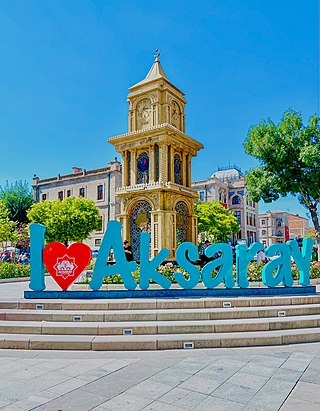
Aksaray is a city in the Central Anatolia region of Turkey. It is the seat of Aksaray Province and Aksaray District. Its population is 247,147 (2021). In 2021 the province had an estimated population of 429,069 distributed over about 7,659 km2 (2,957 sq mi). The average elevation is 980 m (3,215 ft), with the highest point being Mt. Hasan at 3,268 m (10,722 ft).

Bayburt is a city in northeast Turkey lying on the Çoruh River. It is the seat of Bayburt Province and Bayburt District. Its population is 48,036 (2021).

The Fortress of Van is a massive stone fortification built by the ancient kingdom of Urartu during the 9th to 7th centuries BC, and is the largest example of its kind. It overlooks the ruins of Tushpa, the ancient Urartian capital during the 9th century, which was centered upon the steep-sided bluff where the fortress now sits. A number of similar fortifications were built throughout the Urartian kingdom, usually cut into hillsides and outcrops in places where modern-day Armenia, Turkey and Iran meet. Successive groups such as the Medes, Achaemenids, Armenians, Parthians, Romans, Sassanid Persians, Byzantines, Arabs, Seljuks, Safavids, Afsharids, Ottomans and Russians each controlled the fortress at one time or another. The ancient fortress is located just west of Van and east of Lake Van in the Van Province of Turkey.
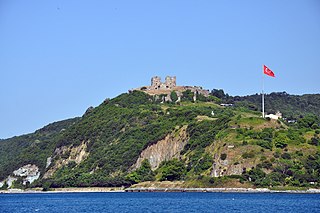
Yoros Castle is a ruined castle dating back to Byzantine times that stands above the confluence of the Bosphorus and the Black Sea, to the north of Joshua's Hill, in Beykoz district, Istanbul, Turkey. It is commonly referred to as the Genoese Castle, due to Genoa’s possession of it in the mid-15th century.
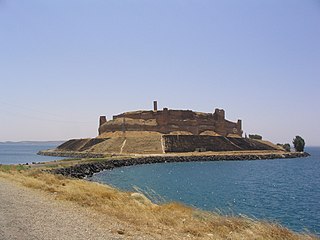
Qal'at Ja'bar is a castle on the left bank of Lake Assad in Raqqa Governorate, Syria. Its site, formerly a prominent hill-top overlooking the Euphrates Valley, is now an island in Lake Assad that can only be reached by an artificial causeway. Although the hilltop on which the castle sits was possibly already fortified in the 7th century, the current structures are primarily the work of Nur ad-Din, who rebuilt the castle from 1168 onwards. Since 1965, several excavations have been carried out in and around the castle, as well as restoration works of the walls and towers. The castle was a Turkish exclave between 1921 and 1973.

The Walled City of Jajce is a medieval fortified nucleus of Jajce in Bosnia and Herzegovina, with Jajce Citadel high above town on top of pyramidal-shaped steep hill, enclosed with approximately 1,300 metres (4,300 ft) long defensive walls,. It is one of the best preserved fortified capitals of the Bosnian Kingdom, the last stronghold before the kingdom dissolved under the pressure of military advancement at the onset of Ottoman Empire takeover.

Mamure Castle is a medieval castle in the Bozdoğan village, Anamur ilçe (district) of Mersin Province, Turkey.

The Walls of Trabzon are a series of defensive walls surrounding the old town of the city of Trabzon, northeastern Turkey. The fortifications are sometimes called the Trabzon Castle. However, they did not function as a castle, rather as city walls. Constructed on foundations dating back to the Roman era with cut stones from former structures at site, the walls stretch from the hill on the backside of the old town to the Black Sea shore. The walls further divided the city into three parts; the Upper Town or "fortress", the Middle Town and the Lower Town. The upper and middle towns are flanked by steep ravines cut by the Zagnos (Iskeleboz) and Tabakhane (Kuzgun) streams to the west and east respectively, while the lower town extends to the west of Zagnos.

Silifke Castle is a medieval castle in Turkey.
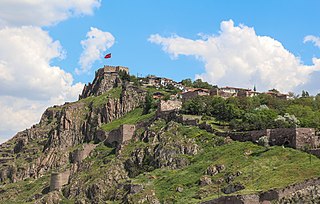
Ankara Castle is a historic fortification in the city of Ankara, Turkey, constructed in or after the 7th century. The earliest fortification on the site was constructed in the 8th century BC by the Phrygians and rebuilt in 278 BC by the Galatians. The castle was rebuilt or renovated under the Roman, Byzantine, Seljuk, and Ottoman Empires.
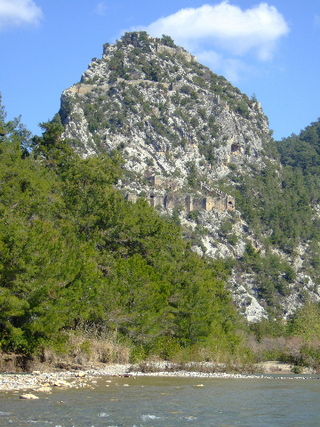
The Alara Castle, is a historic fortification located at Alanya district of Antalya Province in southern Turkey.

Samsun Castle was a castle in Samsun, Turkey. Built on the seaside in 1092, it was demolished between 1909 and 1918.

Rize Castle is a partly-ruined medieval castle located in Rize, northeastern Turkey.
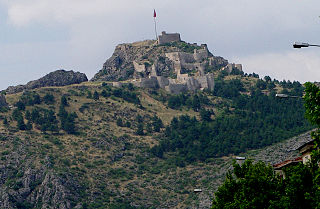
Amasya Castle, a.k.a.Harşene Castle, is a fortress located in Amasya, northern Turkey.

Karaman Castle is in the city of Karaman, Turkey.

Buruciye Medrese or Buruciye Madrasah is a former medrese, in Sivas, Turkey. It was built during the reign of Seljuk sultan Gıyaseddin Keyhüsrev III in 1271.
Karacahisar Castle, Karaca Hisar Castle or Karajahisar Castle is a ruined Byzantine castle on a plateau near the Porsuk River, southwest of Eskişehir, Turkey. It stands 1,010 metres (3,310 ft) above sea level, is surrounded by walls, and covers an area of 60,000 square meters.

Babakale Castle is an 18th-century fortification at Babakale, Ayvacık, the westernmost point of mainland Turkey. It was built during the Ottoman era.
Amasra Fortress or Amasra Castle is located in the Amasra district of Bartın, on the Black Sea coast of Turkey. It was built by the Romans and later restored by the Byzantines, Genoese and Ottomans. It consists of two parts: Sormagir Castle and Zindan Castle. It was added to the Tentative List of World Heritage Sites by UNESCO in 2020.